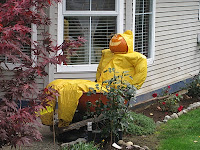 I often get asked if Canadians celebrate certain holidays the same way Americans do, so I decided to start blogging about holidays in Canada as they come about (instead of writing a big blog post about all of them at once, which would probably be massive). There are a lot of commonalities between many US and Canadian holidays in general; however, there are also differences in how and when these holidays are celebrated, some differences being minor and some major. Additionally, Canada also has its own unique holidays that are recognized at a federal and/or provincial level (such as BC Day, which I believe I wrote about before).
I often get asked if Canadians celebrate certain holidays the same way Americans do, so I decided to start blogging about holidays in Canada as they come about (instead of writing a big blog post about all of them at once, which would probably be massive). There are a lot of commonalities between many US and Canadian holidays in general; however, there are also differences in how and when these holidays are celebrated, some differences being minor and some major. Additionally, Canada also has its own unique holidays that are recognized at a federal and/or provincial level (such as BC Day, which I believe I wrote about before). Some are probably wondering why I listed Thanksgiving before Halloween in the title of this post. Unlike Americans who celebrate Thanksgiving in late November, modern day Canadians have officially had Thanksgiving (called Jour de l'Action de grâce in Canadian French) on the second Monday in October since the Canadian Parliament proclaimed it a federal holiday in 1957. Therefore, in case you're having what I like to call "a bad brain day," this means that Thanksgiving occurs before Halloween in Canada.
Even though Thanksgiving is officially on a Monday, Canadians have their Thanksgiving feast (turkey, stuffing, mashed potatoes, cranberry sauce, etc.) on any day of the 3 day weekend, with Sunday and Monday being the most popular. Popular modern American Thanksgiving traditions, such as parades and football games, have been incorporated into Canadian traditions over the years. The only parade that is broadcast nationwide on Thanksgiving Day in Canada is a parade called the Kitchener-Waterloo Oktoberfest parade, which is part of the annual Kitchener-Waterloo Oktoberfest festival, celebrated in the twin cities of Kitchener-Waterloo in Ontario. I fail to see the connection between this festival and Thanksgiving except for the fact that it is nationally televised on the nationally-recognized holiday and supposedly a lot of people watch it on that holiday (even though Jeff has never even heard of it). This is definitely a "Canadian Oddity."
The Canadian Football League (in case you didn't know, Canadians have their own football league that plays under slightly different rules than the American NFL) holds a nationally-televised doubleheader known as the "Thanksgiving Day Classic". The teams that play on Thanksgiving Day vary from year to year.
The Canadian Football League (in case you didn't know, Canadians have their own football league that plays under slightly different rules than the American NFL) holds a nationally-televised doubleheader known as the "Thanksgiving Day Classic". The teams that play on Thanksgiving Day vary from year to year.
The concept of Thanksgiving in Canada and United States is basically the same, but the history behind the holiday differs. I won't go into much depth as it would make for a long, boring post, but in short--let it be first noted that the First Nations peoples of Canada (referring to the Aboriginal peoples of Canada) had regular feasts in thanksgiving and celebration of successful harvests centuries before the Europeans set foot in North America (so there). The first celebration of Thanksgiving by a European in Canada was held in 1578 (the first in the US was held in 1621) by an English explorer, Martin Frobisher, who had been trying to find a northwest passage from the Atlantic to the Pacific Ocean, a feat that explorers before him had failed miserably (meaning they died trying). Since he returned safely from his search (although he didn't find what's now officially known as the Northwest Passage--in fact, it wasn't successfully navigated until 1906), he held a celebration to give thanks for his successful homecoming, although I cannot find anything that says any First Nations peoples attended or were even invited to this event. Interestingly though, Thanksgiving-like feasts were also held by French Settlers in Canada, who apparently happily shared their food with their First Nations neighbors.
Anywho, that's probably more than anyone wanted to know about Thanksgiving in Canada, so onto Halloween. Luckily (as I'm kind of sick of writing for today), Halloween is "celebrated" in the same way in Canada as it is in the US and has the same historical roots. However, to provide a significant historical event pertaining to Halloween: this is the first time Jeff and I will be handing out candy together to trick-or-treaters since we've been married. Last year, none came to our door since the porch light wasn't on (I was not aware of this rule, although I believe Jeff was...shady), so we ate all the candy ourselves. I just took the picture above of our neighbor's Halloween decor. It looks like it probably lights up when plugged in, but I didn't have the guts to run to the neighbor's door and plug it in (maybe I'll take another picture tonight when it's lit up). ;)






